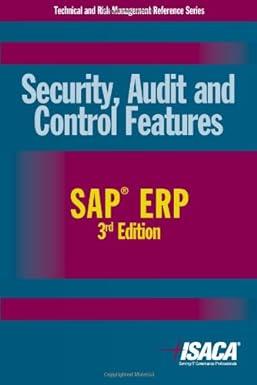Question
Prompt: Answer the seven Discussion Questions in the Managing Inventory at Frito-Lay case in the Case Studies section of Chapter 12. Requirements: A 250-word minimum,
- Prompt: Answer the seven Discussion Questions in the Managing Inventory at Frito-Lay case in the Case Studies section of Chapter 12.
- Requirements: A 250-word minimum, APA compliant paper that adequately addresses each question as well as discussing how Matthew 25:14-30 would apply to this case.
Frito-Lay has flourished since its originthe 1931 purchase of a small San Antonio firm for $100 that included a recipe, 19 retail accounts, and a hand-operated potato ricer. The multibillion-dollar company, headquartered in Dallas, now has 41 products15 with sales of over $100 million per year and 7 at over $1 billion in sales. Production takes place in 36 product-focused plants in the U.S. and Canada, with 48,000 employees.
Inventory is a major investment and an expensive asset in most firms. Holding costs often exceed 25% of product value, but in Frito-Lays prepared food industry, holding costs can be much higher because the raw materials are perishable. In the food industry, inventory spoils. So poor inventory management is not only expensive but can also yield an unsatisfactory product that in the extreme can also ruin market acceptance.
Major ingredients at Frito-Lay are cornmeal, corn, potatoes, oil, and seasoning. Using potato chips to illustrate rapid inventory flow: potatoes are moved via truck from farm, to regional plants for processing, to the warehouse, to the retail store. This happens in a matter of hoursnot days or weeks. This keeps freshness high and holding costs low.
Frequent deliveries of the main ingredients at the Florida plant, for example, take several forms:
Potatoes are delivered in 10 truckloads per day, with 150,000 lbs consumed in one shift: the entire potato storage area will only hold 7 hours worth of potatoes.
Oil inventory arrives by rail car, which lasts only 4 days.
Cornmeal arrives from various farms in the Midwest, and inventory typically averages 4 days production.
Seasoning inventory averages 7 days.
Packaging inventory averages 8 to 10 days.
Frito-Lays product-focused facility represents a major capital investment. That investment must achieve high utilization to be efficient. The capital cost must be spread over a substantial volume to drive down the total cost of the snack foods produced. This demand for high utilization requires reliable equipment and tight schedules. Reliable machinery requires an inventory of critical components: this is known as MRO, or maintenance, repair, and operating supplies. MRO inventory of motors, switches, gears, bearings, and other critical specialized components can be costly but is necessary. Frito-Lays non-MRO inventory moves rapidly. Raw material quickly becomes work-in-process, moving through the system and out the door as a bag of chips in about 11 shifts. Packaged finished products move from production to the distribution chain in less than 1.4 days.
Discussion Questions*
1. How does the mix of Frito-Lays inventory differ from those at a machine or cabinet shop (a process-focused facility)?
2. What are the major inventory items at Frito-Lay, and how rapidly do they move through the process?
3. What are the four types of inventory? Give an example of each at Frito-Lay.
4. How would you rank the dollar investment in each of the four types (from the most investment to the least investment)?
5. Why does inventory flow so quickly through a Frito-Lay plant?
6. Why does the company keep so many plants open?
7. Why doesnt Frito-Lay make all its 41 products at each of its plants?
Step by Step Solution
There are 3 Steps involved in it
Step: 1

Get Instant Access to Expert-Tailored Solutions
See step-by-step solutions with expert insights and AI powered tools for academic success
Step: 2

Step: 3

Ace Your Homework with AI
Get the answers you need in no time with our AI-driven, step-by-step assistance
Get Started


